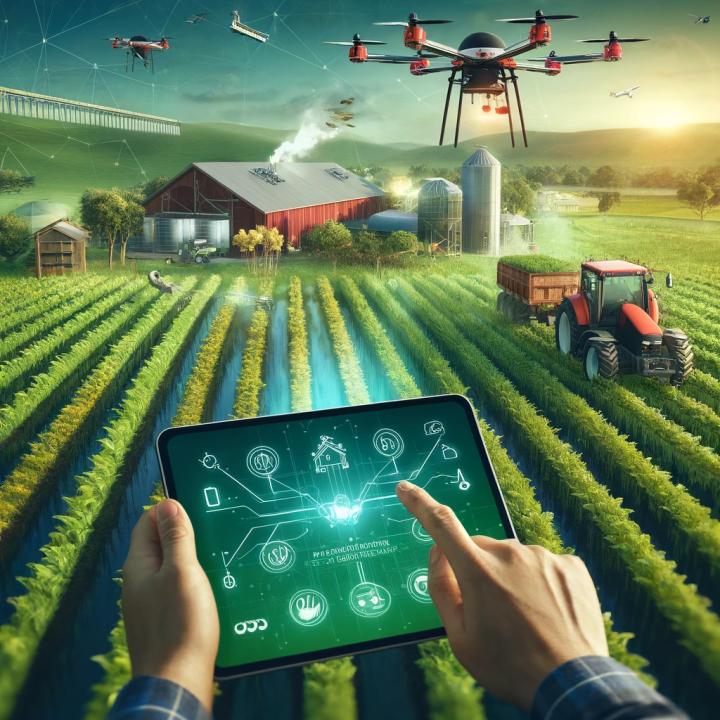As the demand for food continues to rise, farmers are turning to smart agriculture to overcome challenges like climate change, water scarcity, and labor shortages. By leveraging cutting-edge technologies such as IoT, AI, drones, and big data analytics, smart farming enhances productivity, reduces waste, and promotes sustainability.
Governments and private investors are pouring resources into precision agriculture, AI-driven monitoring, and automated irrigation systems to tackle food insecurity. Meanwhile, consumer preferences for organic and sustainably sourced food are accelerating the adoption of digital farming solutions worldwide.
Revolutionizing Agriculture with IoT and AI
The integration of IoT (Internet of Things) and AI (Artificial Intelligence) is reshaping farming, providing real-time insights that optimize decision-making. Here’s how these technologies are revolutionizing the industry:
- IoT-Enabled Sensors – Monitor soil moisture, temperature, and humidity to ensure optimal growing conditions.
- AI-Powered Data Analytics – Predicts weather patterns and recommends best farming practices to maximize yields.
- Smart Drones and Robotics – Use multispectral imaging to assess crop health, detect diseases, and optimize pesticide use.
- Automated Irrigation Systems – Adjusts water distribution based on soil conditions, preventing waste and increasing efficiency.
By replacing traditional guesswork with data-driven decision-making, farmers can boost productivity, cut costs, and reduce environmental impact.
Why is Precision Farming Gaining Popularity?
Precision farming is a rapidly growing trend in smart agriculture, enabling farmers to use resources efficiently and maximize yields. This data-driven approach applies fertilizers, pesticides, and water only where needed, reducing waste and environmental harm.
Key Benefits of Precision Farming:
✅ Higher crop yields through optimized techniques
✅ Reduced environmental impact by limiting excessive chemical use
✅ Lower costs through better resource management
✅ Real-time monitoring of soil health and weather conditions
With global food demand soaring, precision farming is becoming a vital tool for sustainable food production.
The Role of Drones and Robotics in Agriculture
Drones and robotics are game-changers in modern farming, helping automate tasks, cut labor costs, and improve efficiency.
🔹 Crop Health Monitoring – Drones detect diseases early with advanced imaging.
🔹 Automated Harvesting – AI-driven robots speed up fruit and vegetable picking.
🔹 Smart Spraying Systems – Precision drones apply pesticides only where necessary.
🔹 Livestock Monitoring – Smart drones track cattle and detect illnesses.
As technology advances and costs decrease, robotics and AI adoption in agriculture will continue to rise.
Smart Irrigation: Solving Water Scarcity in Farming
With water shortages threatening agriculture worldwide, smart irrigation systems are becoming essential. These systems use IoT sensors and AI-powered analytics to monitor soil moisture and deliver water precisely when needed.
Benefits of Smart Irrigation:
💧 Reduces water waste by up to 50%
🌾 Prevents over-irrigation, which can harm crops
📈 Improves crop health with consistent moisture levels
💰 Lowers operational costs for farmers
With climate change intensifying, efficient water management is no longer optional—it’s a necessity.
How Governments Are Supporting Smart Agriculture
Governments worldwide are investing in digital farming solutions to enhance food security and combat climate-related agricultural challenges.
Notable Government Initiatives:
🌍 European Union – Funding precision agriculture through the Common Agricultural Policy (CAP).
🇺🇸 United States – Investing in AI-driven farming research via the USDA.
🇨🇳 China – Scaling up smart farming technologies to meet rising food demand.
🇮🇳 India – Promoting AI and IoT-driven solutions for small-scale farmers.
These efforts are accelerating market growth and encouraging wider adoption of smart agriculture.
Challenges Facing Smart Agriculture
Despite its promising future, smart agriculture faces several hurdles that must be addressed:
🚧 High Initial Costs – Advanced technology requires significant investment.
📉 Lack of Digital Literacy – Many farmers struggle with adopting new tools.
🔐 Data Privacy Concerns – Securing farm data is a growing challenge.
📡 Infrastructure Gaps – Poor internet connectivity limits access in rural areas.
To overcome these obstacles, tech companies, governments, and agribusinesses must work together to make smart farming solutions more affordable and accessible.
What’s Next for Smart Agriculture?
The future of farming is digital, data-driven, and highly automated. With ongoing advancements in AI, IoT, robotics, and automation, experts predict exponential growth in the smart agriculture market.
Emerging Trends to Watch:
🔹 AI-powered predictive analytics for better crop management
🔹 5G-enabled smart farming for real-time data transmission
🔹 Sustainable vertical farming using hydroponics and aeroponics
🔹 Autonomous tractors and AI-driven robots for labor efficiency
🔹 Smart water management to combat climate change impacts
With global food demand expected to rise sharply, smart agriculture will play a critical role in securing a sustainable food future while reducing environmental harm.
🔹 Smart farming isn’t just the future—it’s happening now. 🌍🌾💡


